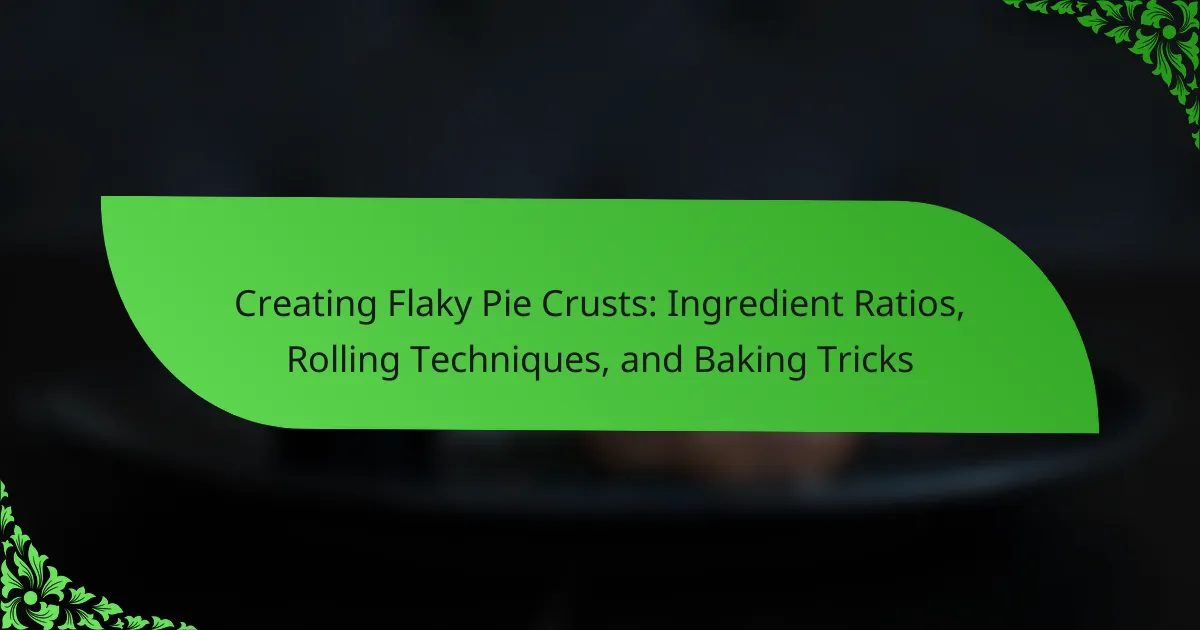Flaky pie crusts are a pastry characterized by their light, airy texture and crisp layers, achieved through the incorporation of solid fat like butter or shortening into flour. This article details the essential ingredient ratios, typically ranging from 1:2 to 1:3 fat to flour, and emphasizes the importance of using cold ingredients and minimal mixing techniques to maintain the integrity of the fat. It also explores rolling techniques that influence texture, highlighting the necessity of even thickness and maintaining cool dough temperatures. Additionally, chilling the dough is discussed as a crucial step for enhancing flakiness, while the combination of butter and shortening is recommended for optimal flavor and tenderness.

What is a flaky pie crust?
A flaky pie crust is a type of pastry characterized by its light, airy texture and crisp layers. This texture is achieved by incorporating solid fat, such as butter or shortening, into the flour. The fat creates pockets of air when baked, resulting in a flaky structure. Proper mixing techniques and the right ratio of fat to flour are crucial for achieving this effect. A well-made flaky pie crust should easily break apart when bitten, providing a satisfying crunch. The ideal fat-to-flour ratio for a flaky crust typically ranges from 1:2 to 1:3. Additionally, using cold ingredients and minimal mixing helps maintain the integrity of the fat, contributing to the desired flakiness.
How is flaky pie crust different from other types of pie crust?
Flaky pie crust differs from other types of pie crust primarily in its texture. It is characterized by a light, airy, and crisp quality. This texture is achieved through the incorporation of solid fats, like butter or shortening, which create layers as they melt during baking. These layers form when the fat is cut into the flour, creating pockets of air. In contrast, other pie crusts, such as mealy crusts, prioritize tenderness over flakiness. Mealy crusts have a finer texture and are often used for custard or cream pies. The distinction lies in the method of fat incorporation and the resulting texture, with flaky crusts providing a more pronounced crunch.
What are the key characteristics of a flaky pie crust?
A flaky pie crust is characterized by its light, airy texture and distinct layers. This texture results from the incorporation of solid fats, like butter or shortening, into the flour. When baked, steam from the fat creates pockets, leading to flakiness. The ideal crust is also tender yet sturdy enough to hold fillings without becoming soggy. A proper balance of fat to flour is crucial, typically around 1 part fat to 2 parts flour. Additionally, cold ingredients and minimal mixing help maintain the desired texture. The crust should have a golden-brown color, indicating even baking.
Why is texture important in a flaky pie crust?
Texture is important in a flaky pie crust because it influences the overall eating experience. A flaky texture creates a light and airy structure, which enhances the enjoyment of the pie. This texture is achieved through the proper incorporation of fat and flour. When fat is cut into the flour, it creates layers that separate during baking. These layers expand as steam forms, resulting in a flaky crust. Research indicates that a flaky texture also contributes to the crust’s ability to hold fillings without becoming soggy. A well-textured pie crust balances tenderness and crispness, making it a key component of a successful pie.
What are the essential ingredients for creating flaky pie crusts?
The essential ingredients for creating flaky pie crusts are flour, fat, and water. All-purpose flour provides the structure needed for the crust. The fat, typically butter or shortening, contributes to the flakiness and tenderness. Water is added to bind the ingredients together and activate the gluten in the flour. The ratio of fat to flour is crucial; a common ratio is 1 part fat to 2 parts flour. This balance ensures a flaky texture while maintaining stability. Chilled ingredients help achieve the desired flakiness by preventing the fat from melting before baking.
How do different types of flour affect the crust’s flakiness?
Different types of flour affect the crust’s flakiness due to their protein content and gluten formation. All-purpose flour typically has moderate protein, resulting in a balanced texture. Cake flour has lower protein, leading to a tender, less chewy crust. Bread flour contains higher protein, which can create a tougher crust if overworked.
Pastry flour strikes a balance with lower protein than all-purpose flour, promoting flakiness while still providing structure. The type of fat used in conjunction with flour also plays a crucial role in flakiness. For example, using butter creates steam pockets that enhance flakiness.
In summary, lower protein flours yield a flakier crust, while higher protein flours can result in a denser texture.
What role does fat play in achieving a flaky texture?
Fat is crucial for achieving a flaky texture in pastry. It creates layers by coating flour particles and preventing gluten formation. When fat is added, it melts during baking, creating steam that lifts the layers. This results in a light, flaky structure. The type of fat used also affects texture; for example, butter adds flavor and a tender crumb. Studies show that a fat-to-flour ratio of around 1:2 yields optimal flakiness.
What ratios of ingredients are ideal for flaky pie crusts?
The ideal ratios of ingredients for flaky pie crusts are typically 3:2:1. This means three parts flour, two parts fat, and one part water. For example, using 3 cups of flour, 2 cups of fat (like butter or shortening), and 1 cup of cold water creates a balanced mixture. This ratio ensures a tender and flaky texture. The fat coats the flour, inhibiting gluten formation, which contributes to flakiness. Additionally, using cold ingredients helps maintain the fat’s solid state during mixing, promoting layers in the crust.
How does the ratio of fat to flour impact the final product?
The ratio of fat to flour significantly affects the texture and flakiness of the final product. A higher fat ratio creates a more tender and flaky crust. This is because fat coats the flour particles, inhibiting gluten formation. Less gluten results in a softer texture. Conversely, a lower fat ratio can lead to a tougher crust due to increased gluten development. For example, a classic pie crust often uses a 1:2 fat to flour ratio for optimal flakiness. Studies show that ratios above 1:1 can yield a more desirable flaky texture. Thus, adjusting the fat to flour ratio is crucial for achieving the intended crust quality.
What is the importance of liquid in the pie crust mixture?
Liquid is essential in the pie crust mixture for hydration and gluten formation. It helps to bind the dry ingredients together, ensuring a cohesive dough. The right amount of liquid prevents the crust from becoming too dry or crumbly. Typically, cold water is used to minimize gluten development, which maintains flakiness. Additionally, liquid aids in the activation of leavening agents, contributing to a lighter texture. Studies show that a proper liquid ratio can significantly impact the final crust quality. For instance, using too little liquid can lead to a tough crust, while too much can make it soggy. Thus, balancing the liquid is crucial for achieving the desired flaky texture in pie crusts.

How do rolling techniques influence flaky pie crusts?
Rolling techniques significantly influence the texture and flakiness of pie crusts. Proper rolling creates layers that expand during baking, resulting in a flaky texture. Techniques such as rolling with minimal pressure help maintain the integrity of fat particles within the dough. This is crucial because larger fat pieces create steam when heated, leading to flakiness. Additionally, rolling from the center outward promotes even thickness, preventing tough spots. Uneven rolling can lead to a dense crust, as it affects how the dough bakes. Research indicates that maintaining a cool dough temperature during rolling is essential for optimal flakiness. This is because warmer dough can cause the fat to melt prematurely, reducing the desired layers.
What are the best practices for rolling out pie crust?
Chill the dough before rolling it out. This helps maintain its structure and prevents it from becoming too sticky. Use a well-floured surface to prevent sticking during the rolling process. A rolling pin should be used with even pressure to create a uniform thickness. Roll from the center outward for consistent results. Turn the dough frequently to maintain a circular shape. If the dough cracks, gently press it back together. Aim for a thickness of about 1/8 inch for optimal flakiness. These practices enhance the texture and integrity of the crust during baking.
How does the thickness of the rolled crust affect flakiness?
Thicker rolled crusts tend to be less flaky than thinner ones. Flakiness in pie crust is achieved through layers of fat and dough. When the crust is rolled too thick, the layers do not separate as effectively during baking. This results in a denser texture rather than a light, flaky one. Research indicates that a thickness of about 1/8 inch is optimal for achieving maximum flakiness. Thinner crusts allow for better steam release, which contributes to the flaky texture.
What tools are recommended for rolling out pie crust?
A rolling pin is the primary tool recommended for rolling out pie crust. It allows for even pressure and consistent thickness. A pastry mat can also be useful, providing a non-stick surface for rolling. Additionally, a bench scraper helps in transferring the rolled crust without tearing. A ruler can ensure uniform thickness, which is important for baking. Chilled tools can prevent the dough from warming up too quickly. This helps maintain the desired flaky texture of the crust.
Why is chilling the dough important before rolling?
Chilling the dough is important before rolling to ensure better texture and handling. Cold dough is firmer and less sticky, making it easier to roll out. This process helps solidify the fat in the dough, which contributes to a flaky texture. When the fat remains solid during baking, it creates steam pockets that lead to flakiness. Additionally, chilling allows the gluten to relax, preventing the dough from becoming tough. A study from the Journal of Culinary Science & Technology found that chilled dough results in a significantly improved crust quality. Therefore, chilling is a crucial step in achieving a desirable pie crust.
How does temperature affect the dough’s texture?
Temperature significantly affects the dough’s texture. Warmer temperatures can cause the fat in the dough to melt, leading to a softer, less flaky texture. Conversely, cooler temperatures help maintain the integrity of the fat, promoting a flakier structure. This is because cold fat creates layers when baked, resulting in a desirable texture. Research has shown that maintaining a temperature below 65°F during mixing and rolling is optimal for achieving a flaky pie crust. The Science of Good Cooking by Cook’s Illustrated emphasizes that temperature control is crucial for the desired dough outcome.
What methods can be used to chill the dough effectively?
To chill dough effectively, refrigerate it for at least 30 minutes. This allows the fats to solidify, which is crucial for a flaky texture. Alternatively, you can freeze the dough for 15-20 minutes if you need a quicker option. Rolling out the dough before chilling can also help it cool faster. Using ice water in the dough mixture can lower the temperature immediately. Additionally, placing the dough between sheets of parchment paper can enhance cooling efficiency. These methods ensure the dough maintains its structure during baking, resulting in a desirable flaky pie crust.

What baking tricks enhance flaky pie crusts?
Chilling the dough enhances flaky pie crusts. Cold temperatures prevent butter from melting too quickly. This allows larger butter chunks to remain in the dough. When baked, these chunks create steam pockets. Steam pockets contribute to a flaky texture. Using a combination of butter and shortening also improves flakiness. Butter provides flavor, while shortening adds tenderness. Additionally, using a light touch when mixing prevents overworking the dough. Overworking can lead to a tough crust instead of a flaky one.
How does oven temperature influence the baking process?
Oven temperature significantly influences the baking process by affecting how heat is transferred to the food. Higher temperatures promote quicker cooking, resulting in a crisp exterior and flaky texture. For example, baking pie crusts at 425°F (220°C) can create a golden-brown surface while keeping the interior tender. Conversely, lower temperatures, like 350°F (175°C), allow for more even cooking but may result in a softer crust. The Maillard reaction, which enhances flavor and color, occurs optimally at higher temperatures. Studies show that maintaining the right oven temperature is crucial for achieving the desired texture and flavor in baked goods.
What is the ideal temperature for baking flaky pie crusts?
The ideal temperature for baking flaky pie crusts is 425°F (220°C). This high temperature helps to create a crisp and flaky texture. Baking at this temperature allows the fat in the crust to melt quickly. This rapid melting creates steam, which contributes to flakiness. Many recipes recommend this temperature for optimal results. It is essential to preheat the oven to ensure even baking. Consistent heat at this temperature prevents the crust from becoming soggy. Therefore, 425°F (220°C) is widely accepted as the best temperature for baking flaky pie crusts.
How does pre-baking affect the crust’s texture?
Pre-baking significantly affects the crust’s texture by creating a firmer and flakier result. This technique allows moisture to escape from the crust before adding the filling. The heat during pre-baking helps to set the fat in the dough, which contributes to a crispier texture. A study by the University of California found that pre-baked crusts have a reduced risk of sogginess. This is particularly important for pies with wet fillings. The process also enhances the overall flavor by promoting browning. Therefore, pre-baking is essential for achieving an ideal pie crust texture.
What techniques can prevent a soggy bottom crust?
To prevent a soggy bottom crust, blind baking is an effective technique. Blind baking involves pre-baking the crust before adding the filling. This process helps set the crust and creates a barrier against moisture. Using pie weights during blind baking can ensure even cooking and prevent bubbling.
Another technique is to brush the crust with an egg wash. An egg wash creates a waterproof layer that reduces moisture absorption. Additionally, using a thicker filling can minimize the amount of liquid that seeps into the crust.
Baking at a higher temperature initially can also help. A hot oven creates steam that sets the crust quickly. Finally, using a combination of flour types, such as all-purpose and whole wheat, can improve crust structure and reduce sogginess.
How does using weights during baking improve the crust?
Using weights during baking improves the crust by preventing it from puffing up. The weights help maintain the shape of the crust while it bakes. This results in a more even and consistent texture. Additionally, using weights ensures that the crust cooks thoroughly. A properly cooked crust has a desirable crispness. Research shows that blind baking with weights leads to a better final product. This technique is commonly used in professional baking to achieve optimal results.
What are the benefits of using a baking stone or steel?
Using a baking stone or steel provides several benefits for baking. These tools retain and distribute heat evenly. This results in a consistent baking temperature. The even heat promotes better crust formation. A baking stone or steel also absorbs moisture from the dough. This dehydration creates a crispier crust. Additionally, they can achieve higher temperatures than standard baking sheets. This is essential for achieving a flaky texture in pie crusts. Studies show that using these tools can improve overall baking results significantly.
What are some common troubleshooting tips for flaky pie crusts?
To troubleshoot flaky pie crusts, ensure the butter is cold. Cold butter creates steam during baking, which leads to flakiness. If the crust is tough, avoid overworking the dough. Overworking develops gluten, making the crust chewy. If the crust shrinks, let the dough rest before rolling. Resting relaxes the gluten, preventing shrinkage. For a dry crust, add a small amount of cold water. Proper hydration is crucial for dough consistency. If the crust is too crumbly, ensure you’re using the right flour type. All-purpose flour is ideal for balance. If the edges brown too quickly, cover them with foil. This prevents burning while the center bakes.
Creating flaky pie crusts involves understanding the key ingredients, ratios, and techniques that contribute to texture and flavor. The article outlines the essential components, including flour, fat, and water, and emphasizes the importance of maintaining the right fat-to-flour ratio for optimal flakiness. It also covers rolling techniques, the significance of chilling dough, and various baking tricks to enhance the final product. Additionally, troubleshooting tips are provided to address common issues encountered when making pie crusts, ensuring a successful and satisfying baking experience.
